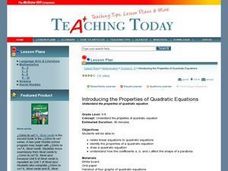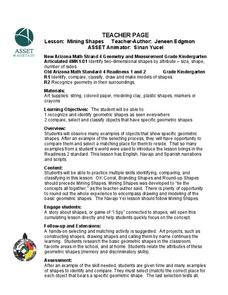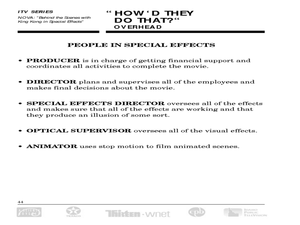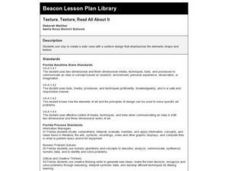Curated OER
Battle of Clontarf
In this Battle of Clontarf worksheet, students read about the battle, answer short answer questions, draw a picture, and make a model of the battle. Students complete 4 activities.
Curated OER
Druidism
In this druidism worksheet, students read about the druidism, answer short answer questions, draw a picture, and make a model of the ring of thirteen stones. Students complete 4 activities.
Curated OER
A Model of a Strato Volcano
Students build a volcano model on tag board. They add lava and ash layers simulating the process that builds a real strato volcano cone.
Curated OER
Modeling Breathing Action
Students create a model to identify the parts of the human respiratory system. They explore the Functional Electrical Stimulation (FES) and its use as a breathing support strategy. Students explore reflex actions as an involuntary...
Curated OER
Mining Shapes
In this 2-D shapes lesson, kindergarteners review plane shapes attributes. They engage in a shape hunt in the classroom and create art using plane shapes. A good, hands-on lesson!
Curated OER
Introducing the Properties of Quadratic Equations
Practice relating linear equations to quadratic equations and identify the properties of a quadratic equation. Draw a quadratic equation and assess how the coefficients a, b, and c affect the shape of a parabola. Create a model of each...
Grapevine Colleyville Independent School District
Mitosis Claymation Lab Instructions and Rubric
A single-paged set of instructions and grading system for a mitosis project are laid out for your life science learners. (Note that the page is repeated, making this a two-page document.) Pairs of beginning biologists use clay to model...
National Gallery of Canada
One Look Is Worth A Thousand Words
Facial expressions can communicate complex emotions. Examine expressions in several hyperrealistic works of art before beginning a project. Learners will create their own clay faces that show an emotion using either photos or their own...
Curated OER
Zany Wire Sculpture
Young artists create a freestanding 3-dimensional sculpture using wire and modeled "clay" pieces. This immensely creative and engaging lesson should get your kids excited, because the medium is unusual to work with. Everything you need...
PBS
The Egg
The first stage in the butterfly's life cycle is the egg. Young entomologists discuss why different butterflies lay different eggs and what their eggs look like. Then they use the handouts to make a replica of one type of butterfly egg...
Curated OER
Animals in Art
Second graders demonstrate visual awareness by listing seven to nine types of animals shown in the artwork on the tour. They draw three types of textured lines or patterns shown in the tour artwork and model an imaginary animal using clay.
Arizona State University
Mining Shapes
Youngsters recognize and identify shapes. They draw, and use modeling clay to make shapes. They also identify shapes in their environment and in the Navajo culture, then compare the shapes and sort them into groups. This is the...
Curated OER
Wreck Detectives
Junior archaeologists examine types of artifacts from the Bronze Age on the internet. In collaborative groups, they create a story about a ship from this period and then construct a model of the ocean floor after their ship has sunk....
Curated OER
Made to Sail
Students use simple materials to make model sailboats which must stay upright and sail straight in a testing tank.
Curated OER
How'd They Do That?
Students research the movie production occupation and careers in the industry. In this movie careers and effects lesson, students watch a video about special effects used in movies and scale. Students draw a building to a specific scale...
Curated OER
The Mound Builders
Fifth graders examine mound building Indian tribes. They identify the two groups of Mound-Building Indians and explore the reasons for building mounds. Students identify places where the mounds exist. They create a model of an Indian mound.
Curated OER
Watershed Island
Middle schoolers make a clay model and a geographic map of a watershed. They talk about the differences between the two representations and the potential human threats to watersheds.
Curated OER
Endangered Animals in Texas
Students research endangered animal in the library and on the Internet for information on its description, habitat, forces causing its decline, and programs to help it; students create slide show about the animal that contains a clay...
Curated OER
Order Out of Borders
Students examine the differences between natural and man-made borders by investigating the Texas quarter. They create clay models of the state of Texas.
Curated OER
Building a Clay Neuron
Students investigate and then build neurons in this lesson. They are examined as key parts of the brain and nervous system and seen as different from normal cells.
Curated OER
Scale Models to Planet Size
Students consider the comparative sizes of the planets in the solar system. In this scale lesson, students select balls of different sizes to represent the planets in the solar system.
Curated OER
Geometry in A Box
Students identify 3-dimensional geometric shapes and list the characteristics of each. Using modeling clay, they create their own models of specified geometric shapes. Students create and design a box to store their geometric models.
Curated OER
Healthy Lungs
Students investigate the lungs and the effects of smoking upon them. They conduct research with the help of using multiple resources. The information is used in order to create the context of models made from clay of healthy and diseased...
Curated OER
Texture, Texture, Read All About It
Fourth graders use clay to create a slab vase with a surface design that emphasizes the elements shape and texture. They complete a self-evaluation of their project which is imbedded in this plan.
Other popular searches
- Clay Modeling Sea Stars
- Clay Modeling Sculpture
- Clay Modeling Planets
- Clay Modeling Horses
- Clay Modeling Communities
- Clay Modeling Pigs
- Clay Modeling and Bartholdi

























